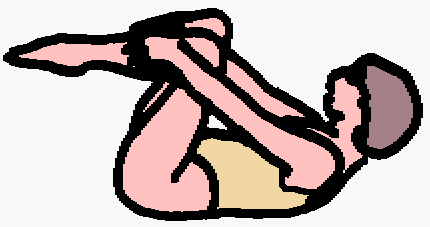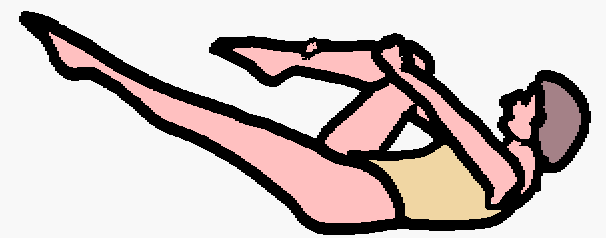|
|
|---|
The Single Leg Stretch (Advanced):- Start Position
- Lie on your back in the relaxation position.
- Breathe in and zip and hollow.
- (Breathing out): Bring one knee up at a time to your chest. Let the toes
just touch (not the heals). Hands placed on outside of calves.
- Breathe in. Pelvic neutral and Scapulas anchored. Check that the elbows
are open - your chest should be able to expand fully.
The Single Leg Stretch (Advanced):- Action
- (Breathe out and maintain zip and hollow): Curl the upper chest up off
the floor. The abdomen and lower chest remain still.
- Breathe in , and place the right hand on the outside of the lower shin,
and the left hand on the inside of the right knee.
- (Breathe out, and still zipping): slowly straighten your left leg to point
toward the wall. It should be at an angle of approximately 45 degrees. Keep your pelvis in
neutral and your scapulas anchored.
- (Breathing in): bring your left knee back to your chest.
- Swap hands over on to the left knee.
- Do the same but on the opposite side.
- Repeat six to eight times each leg.
(Scroll right>>>>....)
|
The Single Leg Stretch (Simple):
Start Position
 Action
Action

Comments
A powerful abdominal exercise, this is another Classic Pilates answer to the
"Trunk-Curl Sit-Up", for which
Shirley Sahrmann lists a total of 13 watch points to avoid injury.
Don't do "Trunk-Curl Sit-Ups!" Do do the Single Leg stretch!
(Related exercises):-
"Perfect Abdominal Curl"
Single leg Stretch (Simple)
|
What it does
- This is a safe but challenging abdominal workout
- Integrates a number of movements combined with core stability.
Great for learning to optimize your body positioning and movement.
Watch Points
- Maintain pelvic neutral, zip and hollow, and scapular anchor!
- Relax your neck (tuck your chin), and keep the upper chest "open".
- Make sure that the sides of the waist remain symmetrical: Don't buckle to the side!
Reference
- Shirley A Sahrmann: Diagnosis and Treatment of Movement Impairment Syndromes;
Publ. Mosby 2002
- The Official Body Control Pilates Manual Available from: http://www.bodycontrol.co.uk/
- Allan Menezies: The Complete Guide to the Pilates Method. Available from www.pilates.net
© Bruce Thomson, EasyVigour Project
scroll up^^^^.....
|
 Action
Action